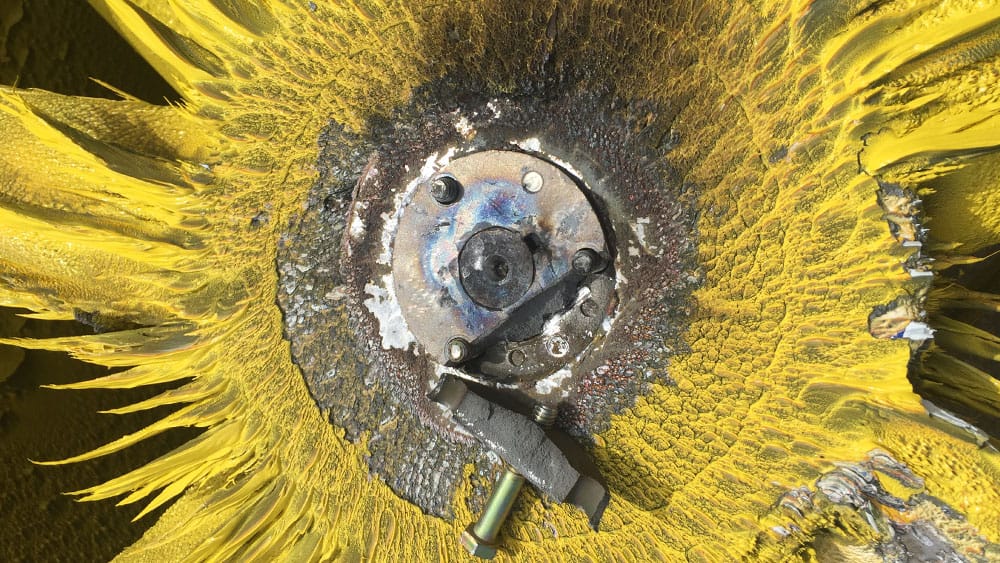
One of the simplest things you can do for the cleanliness and overall productivity of your paint booth is changing the intake and exhaust filters on a regular schedule. Preventative maintenance, in general, decreases the likelihood of your equipment failing, helps keep your paint booth producing efficiently, and keeps the production costs of your shop low.
According to Brandon Lowder, Vice President of Automotive Refinish, Global Finishing Solutions (GFS):
“The number one maintenance mistake shops make is in not following the booth manufacturer’s filter changeout schedule, which for GFS’ exhaust filters, is 100 hours, or about two work weeks.”
Shown below is a prime example why choosing the right filter for your paint booth, as well as performing preventative maintenance on your parts and filters, is so important to your shop’s success. Not only does it directly affect your production output, it also will affect your bottom line of overall shop costs.
Mick Ramis, Business Unit Manager of Parts and Filters, GFS, comments:
“Obviously this fan is not going to be moving the same amount of air as a fan that is in good working condition. The quality of the finished product will likely be affected by poor fan performance.”
Avoiding lost production time and costs should be on every shop owner’s to-do list, and GFS is here to help. Here are our top five tips to ensure long-lasting paint quality and continued production in your shop or business:
The risk of taking short term savings on “cheap” filters is higher than you may think. While you may be saving money in the short term, the cheaper quality of the materials used in the filters will load with paint more quickly, causing you more frequent filter change outs. Additionally, low-cost alternatives have a lower capture efficiency which can lead to an even higher expense of replacing other parts, due to the lack of filtration, such as fans, motors, duct work, etc.
When choosing an exhaust filter material, be sure to choose the correct media for your application. The main goal of exhaust filtration is to protect your fans, stack and plenum from the buildup of overspray contamination without slowing airflow. Exhaust filters need to be able to hold enough paint to avoid constantly replacing the filters, and when you use a lower echelon filter, you open yourself up to more serious issues, such as expensive fan repairs.
Managing your filters and changing procedures with your manometer is key to letting painters and service personnel know when it is time change the filters. Comparing these readings with the booth manufacturer’s specs is ideal. If your booth doesn’t have a differential pressure gauge, it is best to establish a strict maintenance schedule based on the volume of spraying taking place in the booth on a day-to-day basis.
Proper fan inspection and maintenance helps guard against future problems or issues with your exhaust system. Depending on your production rates, you may only need to establish a monthly inspection or maintenance schedule; however, a regular routine must be kept in order to prevent additional maintenance requests and equipment overhaul.
It is also an important step to ensure your paint operation meets the health and safety standards required by OSHA and NFPA. In more severe situations, clogged filters may create flammable or explosive conditions within your booth. With so many different styles and brands, filters will reach their “target” reading and require replacement at varying rates. These rates will depend upon the paint type, booth design, fan speed, temperature and spray equipment.
Ultimately, it is best to work with your paint booth manufacturer or filter supplier to design an effective schedule for changing your filters. This schedule should balance your filtration and booth performance needs with the costs – and savings – of more frequent filter replacement.
One of the best ways to highlight your business is through a story that you can share across your online platforms. It humanizes your business and shows that your business can make a meaningful impact. Your testimonial would be used as a project profile on the GFS Booth Blog and can be shared on your website and/or social media channels.
Complete this form and we’ll be in touch to showcase your company.

Shop a variety of GFS aftermarket products, including booth protection products and mobile accelerated curing units. And enjoy the convenience of fast and free ground shipping throughout the contiguous United States.

Located at GFS’ headquarters in Osseo, Wisconsin, the Center for Excellence is an innovative facility featuring an automotive refinish training center, as well as a separate space dedicated to technical product training.

GFS is continuously searching for talented, ambitious individuals to join our team. We aim to provide our employees with every opportunity to make an impact on the company and find their niche along the way — weather in a production, field services or an office position.